The cheetah is a very fascinating animal and is well known all over the world for its speed. Kids love cheetahs for their speed. It belongs to the cat family but due to certain unique features, it is built specifically for speed. We have gathered a complete list of Cheetah Facts For Kids that will help you in learning all about cheetahs. You are going to learn about its scientific classification, appearance, body parts, special features, size, weight, strength, speed, population, habitat, diet, predators, lifespan, adaptations, life cycle, conservation, and many more things along with pictures and videos.
Cheetah Facts For Kids
1. What is a Cheetah
Cheetah is a large, slender, and spotted cat found across Asia and Africa. It is the fastest land animal on earth.
2. What is the Scientific name for Cheetah – Cheetah Scientific Name
The scientific name for Cheetah is Acinonyx jubatus.
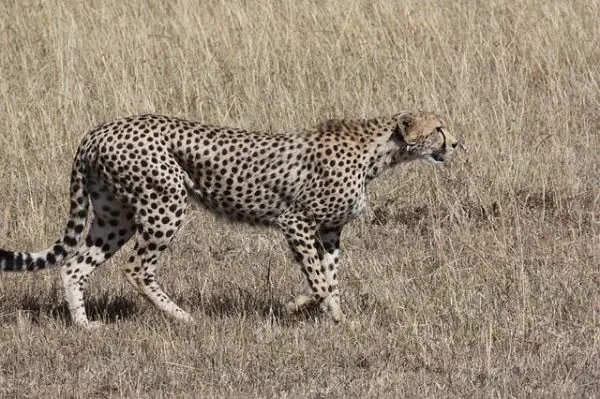
3. Cheetah Classification
| Kingdom | Animalia |
| Phylum | Chordata |
| Class | Mammalia |
| Order | Carnivora |
| Family | Felidae |
| Genus | Acinonyx |
4. Cheetah Description
- The Cheetah is a member of the cat family (Felidae).
- Unlike most other cats, Cheetah hunting depends upon speed instead of stealth.
- It is the fastest mammal on earth with a top speed of 80 to 120 km/h.
- It can go from 0 to 80 km/h in three seconds.
- It is most active during the day and detects its prey by sight.
- It rests during the night to avoid larger predators that hunt at night.
- A Cheetah can’t roar, however it can produce 14 different sounds. It is the only other cat that can purr like a domestic cat.
- It is smaller and lighter than most of the other predators, therefore it runs away rather than fighting them.
- It is the only predator that has no history of attacking any humans in the wild.
5. Cheetah Appearance
- The Cheetah has a long body covered with coarse, smooth fur dotted with black spots.
- It has a long tail which helps it in keeping its balance while running at high speeds.
- The tail is covered in black rings and the tip of the tail is also black.
- The Cheetah has black stripes of fur called “Tear Lines” on its face that run from its eyes along with its nose to its mouth. These “Tear Lines” protect the eyes of the Cheetah from sun-glare.
- It has non-retractable claws which give it a better grip while running at high speeds.
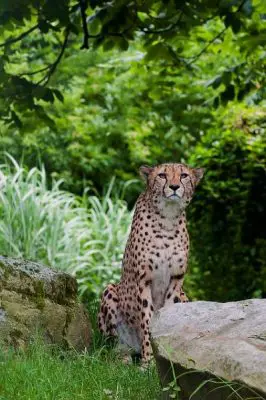
What color is a Cheetah
- A Cheetah is tawny, pale buff, or grayish-white in color with black spots scattered all over its body.
- There are black Cheetahs too, found in Zambia and Kenya.
Black Cheetah
- A black Cheetah’s whole body is black.
- It is found in Zambia and Kenya.
Cheetah Skin
- The Cheetah has a tawny, pale buff, or grayish-white colored skin covered with black spots.
- The skin is covered with fur which is the same color as that of the skin.
6. Cheetah Body Parts
Cheetah Face
- The face of a Cheetah is similar to that of a domestic cat.
- It has a small head with short round ears having white tips.
- Additionally, there are black stripes of fur called “Tear Lines” on its face that run from its eyes along with its nose to its mouth.
Cheetah Eyes
- A Cheetah has extremely amazing eyesight. It can easily spot prey from 5 kilometers away.
- It also has black stripes of fur called “Tear Lines” on its face that run from its eyes along with its nose to its mouth. These “Tear Lines” protect the eyes of the Cheetah from the sun’s glare. These tear lines are similar to the black marks under the eyes of football players.
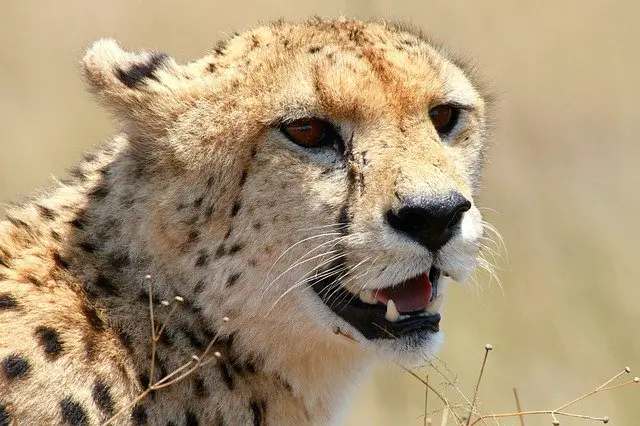
Cheetah Tail
- The Cheetah has a long, heavy, and muscular tail that can measure from 66 to 84 cm.
- It functions as a rudder and stabilizes the body of the Cheetah while running at high speeds. This also enables the Cheetah to take sharp turns at high speeds.
- It also works as a signal for the cubs to follow their mother in tall grass.
- Its color ranges from white to black for different Cheetahs.
7. Cheetah Special Features
- Cheetah is the only cat that can purr other than the domestic cat.
- It is the fastest land animal that can run at a top speed of 80 to 120 km/h.
- It has special non-retractable claws that allow it has a firm grip while running at high speeds.
- It has a long, muscular tail that acts like a rudder and helps it to take sharp turns at very high speeds.
8. What is the Size of a Cheetah – Cheetah Size
- A male Cheetah is usually larger than a female Cheetah.
- The dimensions of the body of a Cheetah are:
- Body length – 112 to 150 cm
- Tail length – 60 to 80 cm
- Shoulder height – 67 to 94 cm
- The average weight of a Cheetah ranges from 21 to 72 kg.
9. How Long is a Cheetah – Cheetah Length
- The body length of a Cheetah is 112 to 150 cm.
- The tail length of a Cheetah is 60 to 80 cm.
10. How Heavy is a Cheetah – Cheetah Weight
- A male Cheetah usually weighs more than a female Cheetah.
- The average weight of a Cheetah ranges from 21 to 72 kg.
11. How Tall is a Cheetah – Cheetah Height
- The shoulder height of a Cheetah ranges from 67 to 94 cm.
12. How Big is a Cheetah – How Big do Cheetahs Get
13. How Strong is a Cheetah
- It is commonly anticipated that the Cheetah is the weakest cat among the big cats.
- However, the Cheetah has a bite force of 475 pounds which is equivalent to that of leopards and cougars.
- It suggests that the Cheetah has a very powerful jaw that is capable of bringing prey as large as a baby giraffe to the ground.
- A Cheetah, however, is not capable of combat. It has weak front legs which are not suitable for combat. That is why a Cheetah can’t stay back and defend its prey against larger predators.
14. Cheetah Speed Facts
- A Cheetah can run at a top speed of 80 to 120 km/h.
- It is the fastest land animal on earth.
- They can maintain this speed only for about 450 meters (i.e. about 1500 feet).
- They can reach accelerate from zero to 100 in just three seconds.
- Cheetah is as fast as the Ferrari when accelerating from zero to 100 km/h.
- Cheetah is 2.7 times faster than us.
Learn more: How Fast Can A Cheetah Run
14. Fastest Cheetah
- The fastest Cheetah in the world is named Sarah, who broke her world record in 2012 by covering a distance of 100 meters in only 5.95 seconds.
- This makes her 38% faster than Usain Bolt – the world record holder for fastest 100 meters dash, who has a world record of 9.58 seconds.
15. Do Cheetahs Roar – Cheetah Roar
- A Cheetah can’t roar, however it can produce 14 different sounds.
- Also, it is the only other cat in its family that can purr like a domestic cat.
- The Cheetah has a one-piece hyoid bone, whereas a cat can roar only with a two-piece hyoid bone.
- The only cats that can roar are the Lion, Tiger, Leopard, and Jaguar.
16. How many Cheetahs are there in the World – Cheetah Population
- There were more than 100,000 Cheetahs in the wild in 1900.
- However, their number has fallen greatly over time.
- Today, there are approximately 7,100 Cheetahs left in the wild which are spread over 33 different populations.
17. How do Cheetahs Survive
- The Cheetahs have evolved and developed many special traits over time.
- They hunt during the daytime when most of the other predators are sleeping.
- Their spotted tawny coats allow them to hide in camouflage while lying in the grass or shade.
- Their semi-retractable claws give them high traction for acceleration and allow them to take sharp turns at high speeds.
- They avoid fighting with other predators and large herbivores because a little damage to its body can be very disastrous. Their high speed and acceleration allow them to escape any predator within no time. It is almost impossible for other predators to attack and hurt a Cheetah.
- However, a mother Cheetah will fight anyone to death to save her cubs.
- They often hide their kills after taking down their prey to save them from other predators and scavengers. However, it is effective only 50% of the time. Lions, Vultures, and Jackals often steal their kills.
18. Cheetah Adaptations
Cheetah Behavioral Adaptations
- A Cheetah chase hides its kill by dragging it into the tall grass, so it doesn’t get stolen by other predators and scavengers.
Cheetah Physical Adaptations
- A Cheetah has longer legs than other cats. Its single stride can cover a distance of up to 23 feet – the same distance a large horse covers in a full stride.
- It has an enlarged heart, liver, lungs, and arteries which ensure that oxygen is provided at a faster rate to the whole body while running at high speeds.
- A faster oxygen supply also requires a high oxygen intake, so a Cheetah has large nostrils. The breathing rate of a Cheetah goes from 60 breaths/min to 150 breaths/min while running.
- It has black tear markings under its eyes which protect against the sun’s glare while hunting.
- It has less developed whiskers which show that a Cheetah is active only during the day.
- It has amazing eyesight which allows it to spot its prey from a distance of 5 kilometers during the day.
- It has semi-retractable claws which provide traction for acceleration and running at high speeds. It also has two “Dewclaws” – one each of its forelegs. When a Cheetah nears its prey during the pursuit, it trips the prey using the dewclaw.
- It has a long, muscular tail that acts as a rudder and allows the Cheetah to take sharp turns at high speeds without falling over.
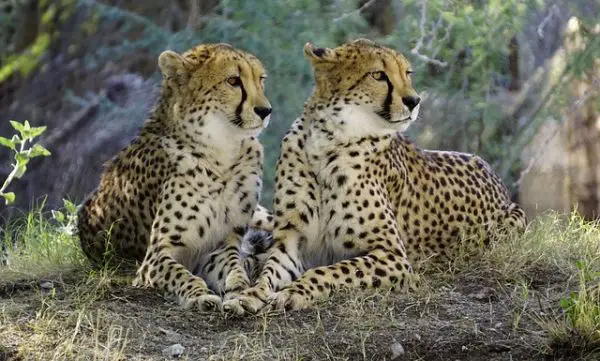
19. Cheetah Heart
- The Cheetah has an enlarged heart which is capable of pumping blood at a very high rate.
- While running at high speeds, the body of a Cheetah requires a lot of oxygen to keep functioning. The enlarged heart performs the function of providing oxygen to the whole body by pumping blood at a faster rate.
20. How Does a Cheetah Move – Cheetah Movement
- A Cheetah moves by contracting its muscles just like any other animal.
- It has an extraordinarily long and flexible spine that allows it to greatly flex its body and increases the reach of its legs while galloping.
- The combination of this spine with long legs and a light body gives the Cheetah outstanding speed, acceleration, and agility.
21. Where do Cheetahs Live – Cheetah Habitat
What Habitat do Cheetahs Live In
- Cheetahs live in dry, open grasslands where they can easily pick up speed to hunt for food without coming across any obstacles.
- Their habitat also contains gazelles, wildebeest calves, and impalas which feed on the grass. These animals are prey for the Cheetahs.
- Cheetahs are made for a dry lifestyle. They drink water only once every three or four days.
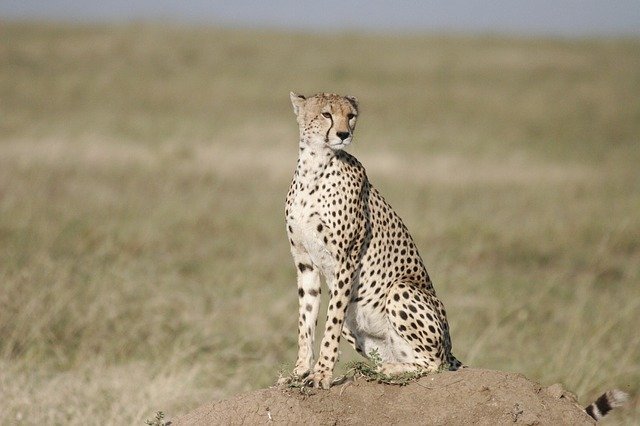
Where are Cheetahs Found
Cheetahs are found in dry and open grasslands which is their natural habitat. It is mostly found in:
- Sub-Saharan Africa
- Eastern and Southern African Parks
- Southern Algeria
- Northern Niger
- Iran
22. Where do Cheetahs Live Map – Cheetah Habitat Map
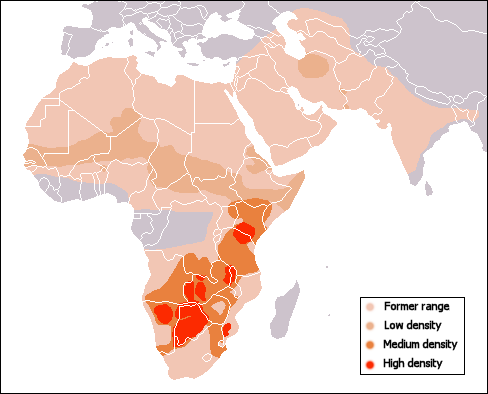
23. Do Cheetahs Live in Groups
- Yes, male Cheetahs live in groups, which are called Coalitions.
- They group up with their brothers or any other lone male Cheetah.
- Female Cheetahs on the other hand are solo hunters and live only with their cubs.
24. What do Cheetahs Eat – Cheetah Diet
- Cheetah like all other cats is a carnivores which means that they eat meat and to get the meat they hunt other animals.
- In the wild Cheetah hunt medium-size wild animals that live in their habitat that can be taken down by speed such as Gazelles.
- In captivity, Cheetahs eat
- Horse meat
- Beef
- Chicken
- Rabbit
- Meat-based feed made specifically for cheetahs
- and cow milk for cubs
25. What are Cheetahs Prey – What do Cheetahs Hunt
- Cheetahs hunt the following animals in grasslands:
- Gazelles
- Wildebeest calves
- Impalas
- Guineafowl
- Gray Duikers
- Kudus
- Springboks
- Ostriches
- Jackals
- Hares
- Birds
Learn in more detail: What Do Cheetahs Eat
26. What Are Cheetahs Predators – Cheetah Predators
- Adult Cheetahs do not have any natural predators.
- However, they can’t put up a fight to defend their dead prey against larger predators, such as the Lion, hyenas, wild dogs, and leopards.
- Cheetah cubs, on the other hand, often fall prey to large eagles, hyenas, lions, and baboons.
27. How Long Do Cheetahs Live – Cheetah Lifespan
- Although the Cheetahs can live up to the age of 20 years, the average lifespan of a Cheetah is:
- 10-12 years in Captivity
- 8 years in the wild
- The cub mortality rate is very high for Cheetahs both in captivity and in the wild.
28. What Is The Life Cycle Of A Cheetah – Cheetah Life Cycle
- The life cycle of a Cheetah starts when it’s a cub.
- It is born completely blind and helpless.
- It weighs 150 grams to 300 grams at birth. It is born with black spots already on its skin
- It develops fast and opens its eyes for the first time at the age of two months. And it starts walking by itself at 4 months of age.
- At 6 months of age, the Cheetah cub stops drinking its mother’s milk and starts eating meat.
- At 18 months of age, the cubs leave their mother and live in a group for another 6 months.
- At the age of 2 years, the female cubs leave the group and the male cubs continue living together for life. Now, this group is called a Coalition.
- After this stage, the Cheetahs hunt for food, mate, and sleep.
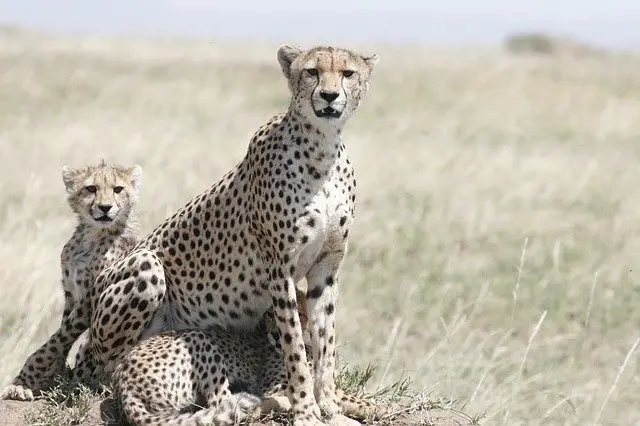
29. How Many Cubs Do Cheetahs Have
- The average litter size of a Cheetah is 3 to 5 cubs.
- The largest litter ever recorded in captivity was 8 cubs, born by a female Cheetah named Bingwa at St. Louis Zoo.
30. What Do Cheetahs Do All Day – Cheetah live
- A Cheetah relies on its eyesight for hunting, so it usually starts its day with hunting during the early morning hours.
- It rests during the afternoon to avoid the high temperatures and is significantly less active during the night.
31. What Do Cheetahs Like To Do
- Cheetahs like to hunt during the early hours of the morning.
- They like to hunt gazelles, jackals, impalas, ostriches, and many other animals.
- They like to rest during the afternoon and nighttime.
32. Different Types Of Cheetahs – Cheetah Species
There are six different types of sub-classifications of Cheetah found in different regions around the world:
- Asiatic Cheetah
- South African Cheetah
- Tanzanian Cheetah (Acinonyx jubatus raineyii)
- Northwest African Cheetah
- Acinonyx jubatus soemmeringii
- Acinonyx jubatus velox
33. African Cheetah
- The African Cheetah is the most abundant Cheetah species on earth found only in Africa.
- Its scientific name is Acinonyx jubatus jubatus.
- It is also called the Namibian Cheetah.
- It is mostly found in Southern Africa.
- The African Cheetah has a bright yellow or golden coat which is thicker than those of other subspecies.
- Its spots are denser than other sub-species. And its tear markings are significantly thicker on the corners of the mouth.
- The African Cheetah is found in:
- Namibia
- Botswana
- South Africa
- Zimbabwe
- Zambia
- Mozambique
- Tanzania
- Swaziland
34. Asiatic Cheetah
- The Asiatic Cheetah is a critically endangered species found in Asian grasslands.
- It is also called the Iranian Cheetah because it is only found in Iran presently and has gone extinct in other Asian countries.
- Its scientific name is Acinonyx jubatus venaticus.
- The Asiatic Cheetah’s fur color ranges from buff to fawn.
- As of December 2017, only 50 Asiatic Cheetah individuals are thought to be left in Iran’s central plateau.
35. Are Cheetahs Endangered
- Yes, Cheetahs are endangered currently.
- Their conservation status is marked as Vulnerable as their population is decreasing over time.
- There total number of Cheetahs left in the world was 7,100 in 2017, which may decrease further over time.
36. Why Are Cheetahs Endangered
- The primary reason for the endangerment of Cheetahs is the loss of habitat.
- As the human population grows, the urbanization of wild areas increases.
- Cheetahs need vast grasslands to hunt for food, which is being turned into cities and villages as the human population increases.
37. Cheetah Conservation
- An organization named Cheetah Conservation Fund (CCF) was founded in Namibia in 1990, which is the global leader in the conservation of Cheetahs.
- This organization is dedicated to scientific research regarding the ecology and genetics of Cheetahs and using scientific ways to conserve the Cheetah population.
38. Cheetah Conservation Status
- Currently, the conservation status of Cheetahs is marked as Vulnerable.
39. FAQs About Cheetah
Is Cheetah a Mammal
- Yes, Cheetah is a mammal, in fact, the fastest mammal on earth.
Are Cheetahs Cats
- Yes, Cheetahs are cats.
- It is a member of the cat family – Felidae. However, it has semi-retractable claws like a dog.
- The cat family consists of 36 different cat species other than Cheetah.
Are Cheetahs Carnivores
- Yes, Cheetahs are carnivores.
- They hunt for prey in open and vast grasslands.
- Their preys include gazelles, impalas, birds, etc.
What Is A Female Cheetah Called – Cheetah Female Name
- There is no special name for a female Cheetah. It is generally referred to as a Female Cheetah.
What Is A Male Cheetah Called
- There is no special name for a male Cheetah. It is generally referred to as a Male Cheetah.
- However, male Cheetahs live in small groups which are called Coalitions. On the other hand, female Cheetahs live alone with their cubs.
Do Cheetahs Live In The Rainforest
- No, Cheetahs don’t and can’t live in the rainforests and wetlands.
- They require vast grasslands for hunting and survival.
Are Cheetahs Friendly
- Yes, Cheetahs are very friendly towards humans.
- It is thought that they only see fast-moving animals as prey.
- They are also reported to have been kept as pets in some cases.
A Group Of Cheetahs Is Called
- A group of male Cheetahs is called a Coalition.
- It usually consists of brothers. Sometimes, a lone male Cheetah also joins the coalition.
- A coalition usually consists of 2 to 6 members.
How Long Have Cheetahs Been Around
- Some fossils of the extinct species of the Acinonyx genus have been found, which date back to the late Pliocene Epoch.
- These fossils are almost three million years old, which suggests that Cheetahs have been running on earth for more than three million years.
What Countries Do Cheetahs Live In
Cheetahs are found in the following countries:
- Namibia
- Botswana
- South Africa
- Zimbabwe
- Zambia
- Mozambique
- Tanzania
- Swaziland
- Iran
Fun Facts About Cheetahs – Interesting Facts About Cheetahs
- The Cheetah is as fast as the Ferrari car when accelerating from zero to 100.
- When a Cheetah is running at full speed, it covers a distance of 6 to 7 meters in one stride.
- Cheetahs can’t defend their dead prey from larger predators. It runs away instead of fighting back. However, a mother Cheetah fights any predator to death for the life of her cubs.
- The super-fast Cheetah chase consumes a lot of energy so it usually lasts less than a minute.
- A female cheetah gives birth to a litter of 2 to 8 cubs at a time.





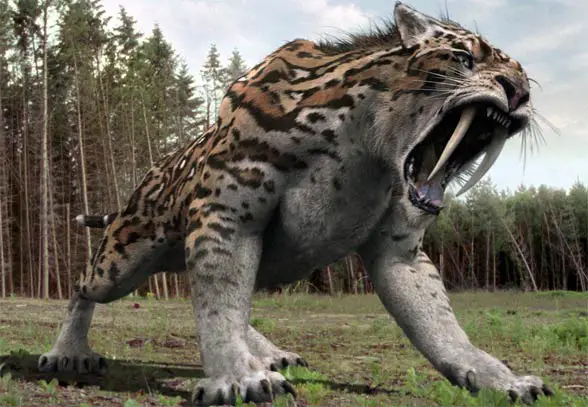






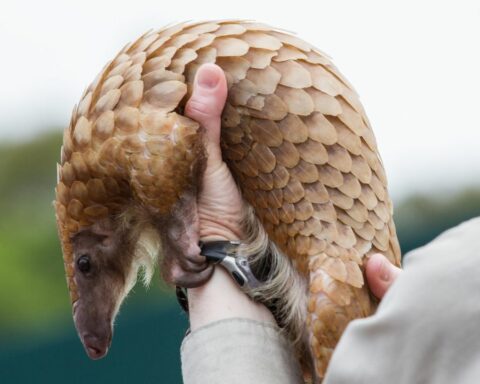
This was very helpfu.
what is a cheetahs life cycle
g’day
Why can’t I have the option to print out this information?